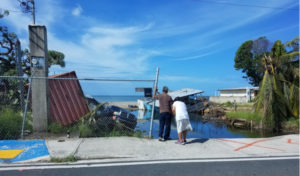In Puerto Rico, Americans are getting a first hand look at how dangerous it can be to rely on government, or anyone else for that matter, to protect you.
Five months after Hurricane Maria devastated the island with punishing wind and rain, Puerto Ricans are still waiting for power in some areas, and over 58,000 homes are covered in blue tarps because residents are waiting for government money to pay for their repairs.
Despite promises to get the power back on and to help rebuild, government can’t do everything. Now, with little hope in recovery, many Puerto Ricans are fleeing the island. USDA researcher calls it a “major depopulation event.” Arelis R. Hernández reports at The Washington Post:
“What we are observing is a major depopulation event that is not extremely common in modern history,” said Lyman Stone, an independent migration researcher and economist at the Agriculture Department who provided models to Puerto Rico. “People kind of treated me like a crazy person when I put it out there.”
Demographers and economists say Stone’s projections appear to be on the high end, but they caution that the Puerto Rican exodus will cut deeply. The Center for Puerto Rican Studies at Hunter College in New York estimates that between 114,000 and 213,000 people will leave the island in 2018, with the vast majority headed for Florida.
Most projections are based in part on volatile airline passenger data tracking the number of people boarding flights leaving the island. Three Florida airports reported 371,000 people traveling commercially from Puerto Rico since October. But so far, fewer than 40,000 people have visited the state’s multiagency service centers set up to assist migrants, and far fewer — about 4,500 — have been issued state driver’s licenses.
The center’s director, Edwin Meléndez, is using school enrollment data from six states receiving Puerto Rican children to more accurately pinpoint migration. Since the hurricane, more than 22,000 students from the island have enrolled in stateside schools. More than half of those — 10,324 students — enrolled in school districts in Florida.
No matter how prepared you are on the ground, i.e. generator, food supplies, water, etc. You should have a plan for evacuation. Where would you go if your home were rendered uninhabitable? Do you have friends or family who would take you in? Do you have a second home or even an RV that could house your family in an emergency? Thinking through your backup plan even for a few minutes can give you a better feel for how ready you are to survive in a disaster. You certainly don’t want to be caught with the unprepared crowd, waiting for government assistance that may never come.
E.J. Smith - Your Survival Guy
Latest posts by E.J. Smith - Your Survival Guy (see all)
- Breaking: New Rules on Trillions in IRAs and 401(k)s - April 24, 2024
- When You’re in Control, You Have Opportunities - April 24, 2024
- Newport, Rhode Island: Sailing, Mansions, and High Taxes - April 24, 2024
- Yes, Money Can Buy You Happiness - April 23, 2024
- State Income Taxes and the 2024 NFL Draft Class - April 23, 2024
















